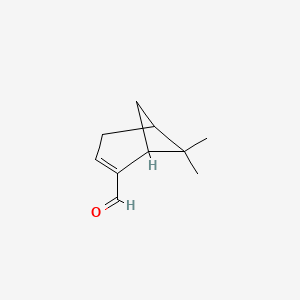| Authors | Title | Published | Journal | PubMed Link |
|---|---|---|---|---|
| Lin GS et al. | Synthesis and Antifungal Activity of Novel Myrtenal-Based 4-Methyl-1,2,4-triazole-thioethers. | 2017 | Molecules | pmid:28125042 |
| Cho S et al. | Aroma chemistry of African Oryza glaberrima and Oryza sativa rice and their interspecific hybrids. | 2014 | J. Sci. Food Agric. | pmid:23907855 |
| Rufino AT et al. | Anti-inflammatory and chondroprotective activity of (+)-α-pinene: structural and enantiomeric selectivity. | 2014 | J. Nat. Prod. | pmid:24455984 |
| Goretti M et al. | Production of flavours and fragrances via bioreduction of (4R)-(-)-carvone and (1R)-(-)-myrtenal by non-conventional yeast whole-cells. | 2013 | Molecules | pmid:23681058 |
| Lingaiah HB et al. | Myrtenal ameliorates diethylnitrosamine-induced hepatocarcinogenesis through the activation of tumor suppressor protein p53 and regulation of lysosomal and mitochondrial enzymes. | 2013 | Fundam Clin Pharmacol | pmid:22436021 |
| Cano-RamÃrez C et al. | Electrophysiological and behavioral responses of the bark beetle Dendroctonus rhizophagus to volatiles from host pines and conspecifics. | 2012 | J. Chem. Ecol. | pmid:22544334 |
| Hari Babu L et al. | Myrtenal attenuates diethylnitrosamine-induced hepatocellular carcinoma in rats by stabilizing intrinsic antioxidants and modulating apoptotic and anti-apoptotic cascades. | 2012 | Cell Oncol (Dordr) | pmid:22722977 |
| Babu LH et al. | Myrtenal, a natural monoterpene, down-regulates TNF-α expression and suppresses carcinogen-induced hepatocellular carcinoma in rats. | 2012 | Mol. Cell. Biochem. | pmid:22763672 |
| Corin K et al. | Insertion of T4-lysozyme (T4L) can be a useful tool for studying olfactory-related GPCRs. | 2012 | Mol Biosyst | pmid:22491779 |
| Lima DK et al. | Evaluation of the antinociceptive, anti-inflammatory and gastric antiulcer activities of the essential oil from Piper aleyreanum C.DC in rodents. | 2012 | J Ethnopharmacol | pmid:22588049 |
Myrtenal
Myrtenal is a lipid of Prenol Lipids (PR) class. The related lipids are Pinene.
Cross Reference
Introduction
To understand associated biological information of Myrtenal, we collected biological information of abnormalities, associated pathways, cellular/molecular locations, biological functions, related genes/proteins, lipids and common seen animal/experimental models with organized paragraphs from literatures.
What diseases are associated with Myrtenal?
There are no associated biomedical information in the current reference collection.
No disease MeSH terms mapped to the current reference collection.
PubChem Associated disorders and diseases
What pathways are associated with Myrtenal
There are no associated biomedical information in the current reference collection.
PubChem Biomolecular Interactions and Pathways
Link to PubChem Biomolecular Interactions and PathwaysWhat cellular locations are associated with Myrtenal?
There are no associated biomedical information in the current reference collection.
What functions are associated with Myrtenal?
There are no associated biomedical information in the current reference collection.
What lipids are associated with Myrtenal?
Related references are published most in these journals:
| Lipid concept | Cross reference | Weighted score | Related literatures |
|---|
What genes are associated with Myrtenal?
There are no associated biomedical information in the current reference collection.
What common seen animal models are associated with Myrtenal?
There are no associated biomedical information in the current reference collection.
